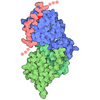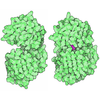+ Open data
Open data
- Basic information
Basic information
| Entry | Database: PDB / ID: 9ujg | ||||||||||||||||||
|---|---|---|---|---|---|---|---|---|---|---|---|---|---|---|---|---|---|---|---|
| Title | Crystal structure of the BTB domain mouse Keap1 | ||||||||||||||||||
 Components Components | Kelch-like ECH-associated protein 1 | ||||||||||||||||||
 Keywords Keywords | TRANSCRIPTION / stress sensor | ||||||||||||||||||
| Function / homology |  Function and homology information Function and homology informationregulation of epidermal cell differentiation / Neddylation / Ub-specific processing proteases / KEAP1-NFE2L2 pathway / Antigen processing: Ubiquitination & Proteasome degradation / negative regulation of response to oxidative stress / Cul3-RING ubiquitin ligase complex / ubiquitin-like ligase-substrate adaptor activity / transcription regulator inhibitor activity / inclusion body ...regulation of epidermal cell differentiation / Neddylation / Ub-specific processing proteases / KEAP1-NFE2L2 pathway / Antigen processing: Ubiquitination & Proteasome degradation / negative regulation of response to oxidative stress / Cul3-RING ubiquitin ligase complex / ubiquitin-like ligase-substrate adaptor activity / transcription regulator inhibitor activity / inclusion body / cellular response to interleukin-4 / actin filament / centriolar satellite / disordered domain specific binding / cellular response to oxidative stress / midbody / ubiquitin-dependent protein catabolic process / in utero embryonic development / proteasome-mediated ubiquitin-dependent protein catabolic process / RNA polymerase II-specific DNA-binding transcription factor binding / protein ubiquitination / regulation of autophagy / regulation of DNA-templated transcription / endoplasmic reticulum / negative regulation of transcription by RNA polymerase II / protein-containing complex / nucleoplasm / identical protein binding / cytosol / cytoplasm Similarity search - Function | ||||||||||||||||||
| Biological species |  | ||||||||||||||||||
| Method |  X-RAY DIFFRACTION / X-RAY DIFFRACTION /  SYNCHROTRON / SYNCHROTRON /  MOLECULAR REPLACEMENT / Resolution: 2.8 Å MOLECULAR REPLACEMENT / Resolution: 2.8 Å | ||||||||||||||||||
 Authors Authors | Iso, T. / Suzuki, T. / Takagi, K. / Mizushima, T. / Yamamoto, M. | ||||||||||||||||||
| Funding support |  Japan, 5items Japan, 5items
| ||||||||||||||||||
 Citation Citation |  Journal: To Be Published Journal: To Be PublishedTitle: Crystal structure of the BTB domain mouse Keap1 Authors: Suzuki, T. / Takagi, K. / Iso, T. / Wen, H. / Zhang, A. / Hatakeyama, T. / Mizushima, T. / Yamamoto, M. | ||||||||||||||||||
| History |
|
- Structure visualization
Structure visualization
| Structure viewer | Molecule:  Molmil Molmil Jmol/JSmol Jmol/JSmol |
|---|
- Downloads & links
Downloads & links
- Download
Download
| PDBx/mmCIF format |  9ujg.cif.gz 9ujg.cif.gz | 45.5 KB | Display |  PDBx/mmCIF format PDBx/mmCIF format |
|---|---|---|---|---|
| PDB format |  pdb9ujg.ent.gz pdb9ujg.ent.gz | 25 KB | Display |  PDB format PDB format |
| PDBx/mmJSON format |  9ujg.json.gz 9ujg.json.gz | Tree view |  PDBx/mmJSON format PDBx/mmJSON format | |
| Others |  Other downloads Other downloads |
-Validation report
| Summary document |  9ujg_validation.pdf.gz 9ujg_validation.pdf.gz | 425.5 KB | Display |  wwPDB validaton report wwPDB validaton report |
|---|---|---|---|---|
| Full document |  9ujg_full_validation.pdf.gz 9ujg_full_validation.pdf.gz | 428.4 KB | Display | |
| Data in XML |  9ujg_validation.xml.gz 9ujg_validation.xml.gz | 7.9 KB | Display | |
| Data in CIF |  9ujg_validation.cif.gz 9ujg_validation.cif.gz | 9.4 KB | Display | |
| Arichive directory |  https://data.pdbj.org/pub/pdb/validation_reports/uj/9ujg https://data.pdbj.org/pub/pdb/validation_reports/uj/9ujg ftp://data.pdbj.org/pub/pdb/validation_reports/uj/9ujg ftp://data.pdbj.org/pub/pdb/validation_reports/uj/9ujg | HTTPS FTP |
-Related structure data
| Similar structure data | Similarity search - Function & homology  F&H Search F&H Search |
|---|
- Links
Links
- Assembly
Assembly
| Deposited unit | 
| ||||||||||||
|---|---|---|---|---|---|---|---|---|---|---|---|---|---|
| 1 | 
| ||||||||||||
| Unit cell |
|
- Components
Components
| #1: Protein | Mass: 14590.904 Da / Num. of mol.: 1 / Mutation: S172A Source method: isolated from a genetically manipulated source Source: (gene. exp.)   |
|---|---|
| Has protein modification | N |
-Experimental details
-Experiment
| Experiment | Method:  X-RAY DIFFRACTION / Number of used crystals: 1 X-RAY DIFFRACTION / Number of used crystals: 1 |
|---|
- Sample preparation
Sample preparation
| Crystal | Density Matthews: 2.38 Å3/Da / Density % sol: 48.21 % |
|---|---|
| Crystal grow | Temperature: 277 K / Method: vapor diffusion, hanging drop Details: 100mM Bis-Tris Propane (pH 6.5), 200mM LiCl, 13% PEG 3350, 4% Sucrose |
-Data collection
| Diffraction | Mean temperature: 100 K / Serial crystal experiment: N |
|---|---|
| Diffraction source | Source:  SYNCHROTRON / Site: SYNCHROTRON / Site:  SPring-8 SPring-8  / Beamline: BL44XU / Wavelength: 0.9 Å / Beamline: BL44XU / Wavelength: 0.9 Å |
| Detector | Type: DECTRIS EIGER X 16M / Detector: PIXEL / Date: Jul 28, 2022 |
| Radiation | Protocol: SINGLE WAVELENGTH / Monochromatic (M) / Laue (L): M / Scattering type: x-ray |
| Radiation wavelength | Wavelength: 0.9 Å / Relative weight: 1 |
| Reflection | Resolution: 2.8→37.08 Å / Num. obs: 4087 / % possible obs: 99.7 % / Redundancy: 7.6 % / Biso Wilson estimate: 92.54 Å2 / CC1/2: 0.999 / Net I/σ(I): 16.11 |
| Reflection shell | Resolution: 2.8→2.96 Å / Num. unique obs: 1069 / CC1/2: 0.724 |
- Processing
Processing
| Software |
| ||||||||||||||||||||||||
|---|---|---|---|---|---|---|---|---|---|---|---|---|---|---|---|---|---|---|---|---|---|---|---|---|---|
| Refinement | Method to determine structure:  MOLECULAR REPLACEMENT / Resolution: 2.8→37.08 Å / SU ML: 0.1781 / Cross valid method: FREE R-VALUE / σ(F): 1.38 / Phase error: 20.0749 MOLECULAR REPLACEMENT / Resolution: 2.8→37.08 Å / SU ML: 0.1781 / Cross valid method: FREE R-VALUE / σ(F): 1.38 / Phase error: 20.0749 Stereochemistry target values: GeoStd + Monomer Library + CDL v1.2
| ||||||||||||||||||||||||
| Solvent computation | Shrinkage radii: 0.9 Å / VDW probe radii: 1.1 Å / Solvent model: FLAT BULK SOLVENT MODEL | ||||||||||||||||||||||||
| Displacement parameters | Biso mean: 96.09 Å2 | ||||||||||||||||||||||||
| Refinement step | Cycle: LAST / Resolution: 2.8→37.08 Å
| ||||||||||||||||||||||||
| Refine LS restraints |
| ||||||||||||||||||||||||
| LS refinement shell | Resolution: 2.8→2.9 Å
|
 Movie
Movie Controller
Controller



 PDBj
PDBj




